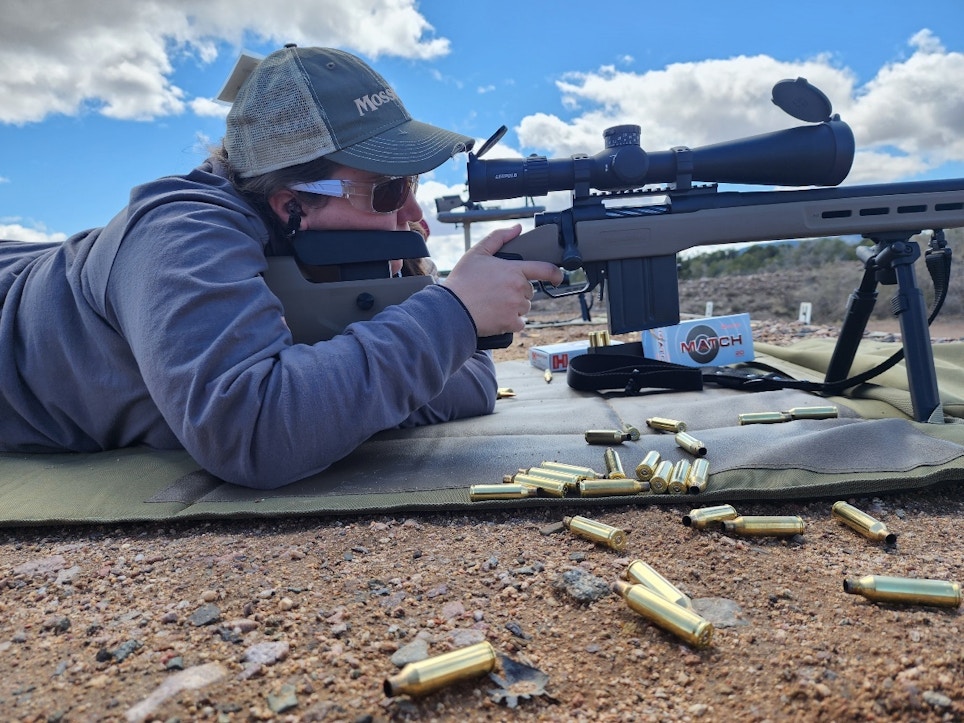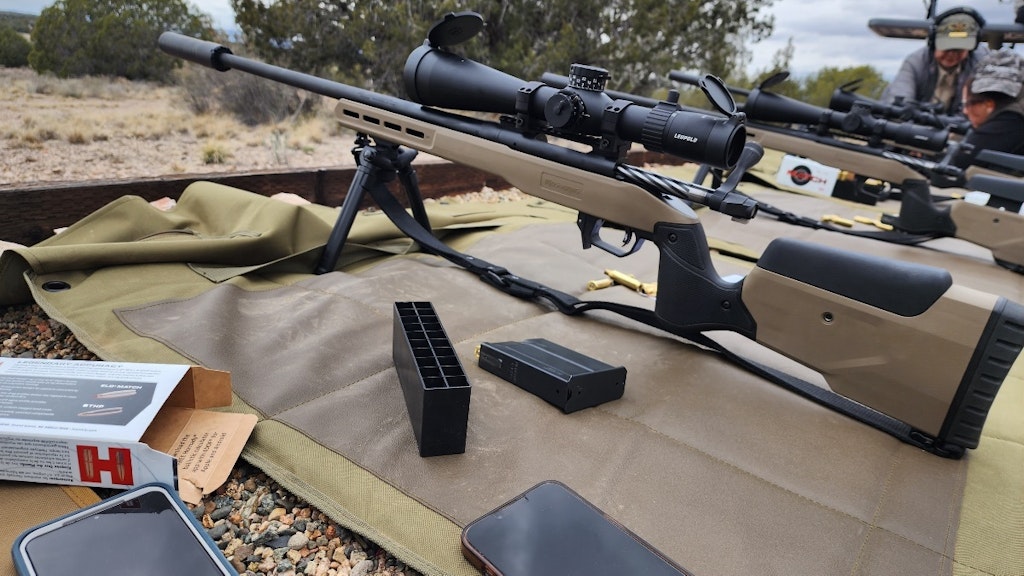
Adjustability built into a stock is a major selling point in a mid-level-price-point long-range rifle.
A few months ago, I spent a week at Gunsite Academy in Arizona taking a long-range shooting class with a group of female outdoor writers. Led by range instructors Mario Marchman and Il Ling New, we put hundreds of rounds through the new-for-2023 Mossberg Patriot LR (Long Range) Tactical in 6.5 PRC. We were all experienced long-range shooters, and the guns and ammo performed near-flawlessly, but we did run into a few quirks throughout the week that took a little problem-solving.
If you’ve got customers coming into the store who are just getting started in precision shooting and they’re experiencing less-than-ideal results, put your expertise to use and help them get back on track. That sometimes even means upgrading their equipment, which leads to a real sales opportunity. But whether it puts money directly in your pocket or not, establishing your store as a place shooters can go to for advice and troubleshooting will pay dividends down the road.
Customers who aren’t getting the desired results out of their long-range setup might be running into one of the following problems.
Form and Fit Problems
A gun has to fit a shooter well in order for them to shoot it properly, and customers just getting started probably aren’t ready to invest in a custom stock. A gun with built-in adjustability is the answer. The Mossberg Patriot LR Tactical has an adjustable cheek piece that can be raised by up to two inches, and spacers are provided to adjust the recoil pad and thus adjust length of pull by as much as ¾-inch. If you know your customer is shooting a good gun and suitable ammo, start with gun fit as one possible trouble spot that might be throwing them off.
Also discuss proper form. If they’re shooting prone, are they “loading” their bipod by leaning their body weight into it? Are they finding their natural point of aim where their body is relaxed when the crosshairs are on target (good), or are they muscling the gun into position for each shot (not good)? Are they executing a smooth, straight trigger press at their natural respiratory break in between breaths? Are they following through after the shot, keeping their body still and their head on the gun and the trigger pressed back for a second?
If your customer’s form and technique need serious work, suggest some training based on their time and budget constraints. If they have the ability to visit Gunsite Academy, I can’t recommend it highly enough as a place to drill the fundamentals, receive excellent training, and work out their form and technique missteps under the watchful eye of some of the world’s best instructors. Plus, the Arizona dust and dirt make Gunsite an excellent proving ground for any firearm. If it’ll run in the desert, it’ll run anywhere.
Rifle Problems
Not all rifles are meant for long-range shooting. Customers don’t need a purpose-built long-range gun to shoot at 1,000 yards and beyond, but the more serious a shooter gets about long-range precision, the more a dedicated firearm like the Patriot LR Tactical makes sense. The aluminum V-block bedding in this gun allows for added barrel stability, and features like a 24-inch bull barrel (threaded), oversized bolt handle, top-mounted 20 MOA Picatinny rail, and user-adjustable Lightning Bolt Action trigger (2 to 7 pounds) make it ideal for long-range shooting. At 9.4 pounds, it's not overly heavy for this category, but it’s comfortable to shoot for long range days.
An off-the-shelf rifle without some of these long-range-specific features is just not going to perform to a shooter’s expectations and might require some upgrades — like a trigger job or a canted rail — to function well past a few hundred yards. And a purpose-built long-range gun will have extra nice-to-have features as well, like the Patriot LR Tactical’s ability to accept AICS magazines.
Ammo Problems
As mentioned, the Patriot LR Tactical I tested was chambered in 6.5 PRC, which is a cartridge specifically designed for long-range shooting. It’s got a high BC, shoots flat, retains energy well and has less wind drift than other chamberings — think of it almost as a magnum version of the ubiquitous 6.5 Creedmoor. We were shooting Hornady Match ammo with a 147-grain ELD Match bullet, which proved an excellent and accurate complement to the rifle. We also made extensive use of Hornady’s ballistics app.
If your customer has made the mistake of grabbing any old ammo off the shelf and expecting cloverleaf groups at distance, give them a quick education on what match ammo is and why it’s important. The short summary: Match ammo is more consistent batch to batch and round to round. Because the manufacturing tolerances are lower than they are with hunting ammo, there’s less variation from shot to shot, and customers can expect better accuracy.
Many brands will work here, but I’ve had great luck with Hornady, and using their ammo with their app — which is probably the most robust app I’ve worked with — makes things easy.

Twist Rate Problems
Manufacturers generally optimize their rifle’s twist rate to work best with the most common bullets they expect to be used, but if a customer is struggling with erratic hits, double-check that their twist rate and ammo are a suitable match. If the twist rate is too slow and the bullet spins too slowly, it will destabilize and eventually start to tumble. Keyhole rips in paper targets rather than perfect circles are a clear indicator of this problem. On the other hand, if the twist rate is too fast and the bullet spins too rapidly in flight, it can begin to wobble out of control, especially if there’s any manufacturing imperfection in the bullet’s center of mass (which there always is to some degree, as no manufacturing is 100% flawless).
In general, lighter (thus shorter) projectiles need a slower twist rate. The Patriot LR Tactical’s twist rate is 1:8, which is optimal for the 147-grain projectiles I was testing. Twist rate issues aren’t a problem you’ll run into very often, as rifle manufacturers do a pretty good job of matching twist rates to the most common ammo, but if your customer is shooting a chambering with a huge range of bullet lengths/weights, it might be something to take a look at, especially if their chosen projectile is on the high or low end of the spectrum.
Optics Problems
“Buy an affordable rifle and put the money saved into better glass,” instructor Il Ling New emphasized during our class. Some customers will drop five figures into high-end rifles and scopes, but your bread-and-butter long-range customers will be at the more moderate end of the price spectrum, at least starting out. That makes a $1,000-or-so rifle like the Patriot LR Tactical and a quality scope like the Leupold Mark 5 HD (MSRP $2,199) I used a solid combination that will take a customer a long way down the precision road for a reasonable upfront cost.
The scope matters as much or nearly as much as the rifle in long-range shooting. Inferior lenses and coatings affect light transmission and overall image quality, which becomes more and more important as the distance increases.
If the customer hasn’t bought a scope yet, steer them toward one with adjustable parallax, ballistic turrets with a zero lock dial, and a larger tube, which allows for a greater range of adjustability. The Leupold Mark 5HD offers features like the company’s Twilight Max HD Light Management Systems for clear, bright images in low light and reduced glare, and a versatile 5:1 zoom ratio. Don’t let your customers buy more magnification or a larger objective lens than they need — it’s a waste and can even be a hindrance.
Adjustability can be a problem on long-range scopes, which is why many rifles (including the Patriot LR Tactical) come with a 20 MOA rail. This essentially ‘tilts’ the scope on the rifle and allows the user to take advantage of the full reticle rather than just half of it. If a customer comes to you and says they’ve adjusted their elevation as far as the scope will go but still can’t get on target, a 20 MOA rail (or even more) is in order.
If a customer feels like they’re shooting well but having trouble holding left and right for wind and still getting hits, they could just be lousy at wind reading, or they could be inadvertently experiencing problems reading their hashmarks. A second focal plane scope is often the culprit. In a SFP scope, those hashmarks only represent 1 MOA each (or whatever the stated measurement is) when the scope is dialed to full magnification. If the customer has their 5-25X scope set anywhere less than 25X, the hashmarks aren’t 1 MOA apart anymore, leading to all sorts of holding errors and math problems. A first focal plane scope solves this problem and takes all guesswork (and math) out of the windage equation, because its hashmarks will always represent the same value no matter what magnification the shooter is using. For this reason, first focal plane scopes are preferred by many long-range shooters.
Environmental Factors
Things like air temperature, humidity, elevation and station pressure can all have slight impacts on how bullets travel at long ranges. There’s not much you as a retailer can do about any of these, but a good ballistics app will take most of this information into account based on some level of input from the shooter. Encourage your customers to download a robust app like Hornady’s (free) or Applied Ballistics Mobile (not free, but it comes highly recommended) to make the most of their long-range setup.




